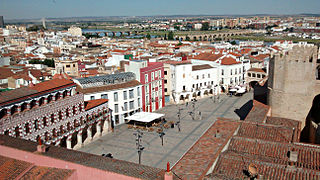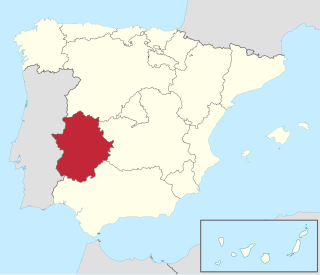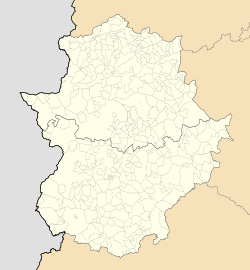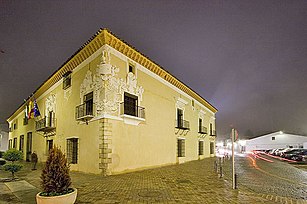
Badajoz is the capital of the Province of Badajoz in the autonomous community of Extremadura, Spain. It is situated close to the Portuguese border, on the left bank of the river Guadiana. The population in 2011 was 151,565.

Extremadura is a landlocked autonomous community of Spain. Its capital city is Mérida, and its largest city is Badajoz. Located in the central-western part of the Iberian Peninsula, it is crossed from east to west by the Tagus and Guadiana rivers. The autonomous community is formed by the two largest provinces of Spain: Cáceres and Badajoz. Extremadura is bordered by Portugal to the west and by the autonomous communities of Castile and León (north), Castilla–La Mancha (east), and Andalusia (south).

Mérida is a city and municipality of Spain, part of the Province of Badajoz, and capital of the autonomous community of Extremadura. Located in the western-central part of the Iberian Peninsula at 217 metres above sea level, the city is crossed by the Guadiana and Albarregas rivers. The population was 60,119 in 2017.

The province of Badajoz is a province of western Spain located in the autonomous community of Extremadura. It was formed in 1833. It is bordered by the provinces of Cáceres in the north, Toledo, Ciudad Real in the east, Córdoba in the south-east, Seville, and Huelva in the south and Portugal in the west.

Cáceres is a city and Spanish municipality located in the center of the autonomous community of Extremadura. It is the capital and most populated municipality of the province of Cáceres and houses the headquarters of the Superior Court of Justice of Extremadura.

Trujillo is a municipality located in Extremadura, an autonomous community of Spain in the Province of Cáceres. In 2013 the municipality had 9,086 inhabitants. Originally settled on a granite knoll, which was readily fortified, the town now extends to the southeast of its original site. Trujillo is both a centre for tourism, with more than 25 hotels, and a regional market town.

Club de Fútbol Extremadura was a Spanish football team based in Almendralejo, in the autonomous community of Extremadura. Founded in 1924, it played two seasons in La Liga, and held home games at Estadio Francisco de la Hera, with a capacity of 11,580 seats. The club folded in 2010 following several years of financial problems.
The Battle of Badajoz was one of the first major engagements of the Spanish Civil War, resulting in a tactical and strategic Nationalist victory, however at a significant cost in time and troops. After several days of shelling and bombardment, Nationalists stormed the fortified border city of Badajoz on August 14, 1936, cutting off the Spanish Republic from neighbouring Portugal and linking the northern and southern zones of Nationalist control.
The Battle of Mérida saw the Republican militia twice fail to halt the Spanish Army of Africa near the historic town of Mérida early in the Spanish Civil War.
Valverde de Llerena is a municipality in the province of Badajoz, Extremadura, Spain. It has a population of 763 and an area of 41 km2.

The Badajoz massacre occurred in the days after the Battle of Badajoz during the Spanish Civil War. Between 500 and 4,000 civilian and military supporters of the Second Spanish Republic were murdered by the Nationalist forces after the seizure of the town of Badajoz on August 14, 1936.

Extremadura Unión Deportiva was a Spanish football team based in Almendralejo, in the autonomous community of Extremadura. Founded in 2007, it last played in Primera División RFEF – Group 1, holding home games at Estadio Francisco de la Hera.

Extremadura Unión Deportiva Femenino, formerly known as CF Puebla Extremadura and later as Extremadura Femenino CF, was a Spanish women football club from Almendralejo.
Diego José Rangel Monge is a Spanish retired professional footballer who played as a central defender.

The first siege of Badajoz was a siege carried out during the Peninsular War on the Spanish town of Badajoz, by the French general Soult.
The Extremadura campaign was a campaign in Extremadura, Spain during the Spanish Civil War. It culminated in the Battle of Badajoz in August 1936, from which the troops of the Army of Africa under the command of Francisco Franco moved quickly to begin the march to Madrid.
José Antonio Pardo Lucas is a Spanish professional footballer who plays as a central defender for Extremadura 1924.

The Monastery of San Isidro de Loriana was a sixteenth-century Franciscan monastery. It is located in the municipality of Mérida, Spain, in Badajoz, in the Cordobilla de Lácara, within the Sierra de San Pedro. The municipalities of La Roca de la Sierra and Puebla de Obando are nearby. San Isidro de Loriana was declared Bien de Interés Cultural on 12 November 2013 in the category of monument. It is an example of Franciscan architecture.

The Medal of Extremadura is the highest institutional distinction of the Autonomous Community of Extremadura, Spain. It was established in 1986, following Decree 27/1986, of 29 April.

Miss Grand Extremadura is a Spanish regional female beauty pageant, founded in 2018 to select representatives from the community of Extremadura for the Miss Grand Spain national competition.



















